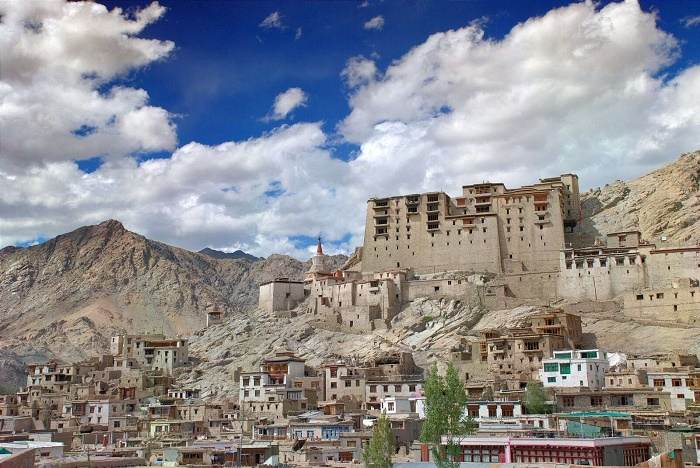When was it built: Construction started in 1553 and completed in the 17th century
Who built it: Initiated by Tsewang Namgyal and completed by Sengge Namgyal, both from the Namgyal dynasty of Ladakh
Where is it located: Leh, Ladakh, in the state of Jammu and Kashmir, India
Why was it built: As Royal Palace
Architectural Style: Medieval Tibetan architecture
Visit Timing: Daily, 7.00 AM to 4.00 PM

Leh Palace also referred as the ‘Lhachen Palkhar’ is a yesteryear royal palace located in the picturesque Ladakhi Himalayan town of Leh in the state of Jammu and Kashmir, India. Designed in line with the Potala Palace in Lhasa, Tibet, the construction of the Leh Palace began in the sixteenth century and it was completed in the 17th century, marking it as one of the tallest buildings of that era with nine storeys. The roof top of the palace provides spectacular views of the mountain of Stok Kangri and the Ladakh mountain range as also panoramic views of the entire town and its surroundings. The palace is now in a dilapidated condition being maintained by the ‘Archaeological Survey of India’ (ASI). However the majestic building with a museum holding over 450 years old artefacts in the midst of the mountains that provide breathtaking views of the snow clad mountain ranges attracts tourists to this palace.

Image Credit: http://culturalsindia.blogspot.in/2011/09/leh-palace.html
History
Founder of the Namgyal dynasty of Ladakh, Tsewang Namgyal embarked on building the Leh Palace on the Tsemo Hill in 1553. The construction of this regal building was completed in the 17th century by Sengge Namgyal known as the 'Lion' King. He was the nephew of Tsewang Namgyal. While the upper floors of the nine-storied palace were used for residential purpose by the royal family, the lower floors had storerooms and stables. The royal family had to desert the palace and shift to Stok Palace in the mid 19th century as the Dongra forces invaded and took over Ladakh. The palace not only remained a helpless witness to some severe wars but also faced the wrath of such wars manifested by the serious damage it suffered from cannon balls.

Image Credit: https://bnomadic.files.wordpress.com/2013/07/img_9414.jpg
Architecture
Although smaller in size, this palace resembles Lhasa’s Potala Palace and stands in the midst of the mountains as an excellent example of medieval Tibetan architecture. The jutted out wooden balconies and the huge buttressed wall are the primary features of this architectural style. The palace is built of stones, wood, mud and sand. The walls of the palace being constructed with wood and mud helps keep the scorching heat away, thus creating a soothing and pleasant temperature inside. The entrance of the palace is decorated with wood carved figurines. Although the palace is in ruins, some small compartments, few spacious rooms and corridors still exist. The bigger rooms and corridors of the palace have been turned into exhibition halls. Some murals that managed to remain visible in the dilapidated walls of the palace depict the majestic grandeur of the past. The famous Victory Tower lies just above the palace which was constructed to commemorate the brave fight put up by the Ladakhi soldiers against the invading Balti Kashmiri soldiers in the 16th century that saw the Ladakhi brave hearts winning the battle.

Image Credit: http://cdn.indiamarks.com/wp-content/uploads/leh-palace.jpg
Attractions
This grand royal palace overlooking the Namgyal hill lying atop the old Leh city seated in the midst of beautiful landscapes and mountain ranges has managed to retain its mystique. It has become a popular tourist destination in Leh apart from being an important hub of Buddhist culture and religion. It not only provides spectacular views but also let one walk through the rich past. A statue of Lord Buddha is seated inside the monastery of the palace. Old pictures and paintings are displayed in the exhibition halls of the palace that include Tibetan thangka or sooth paintings showcasing fine designs. These paintings that are over 450 years old were created using colours derived from powdered stones and gems and till date amaze all with their rich and vivid appearance. The palace is also a house to a rich collection of crowns, ceremonial dresses and jewellery among others. The palace looks even more ravishing on a full moon night raising the mystic charm.

Image Credit: https://bnomadic.files.wordpress.com/2013/07/img_9415.jpg
A Visit to the Palace
The Leh Palace that at present serves as an office of Archaeological Conservation Organization of the government of India remains open for the public from 7.00 AM to 4.00 PM. Entry fees per person for Indian citizens is Rs. 15/- and for foreigner nationals is Rs. 100/-. As the place is in the lap of the mountains, the best time to visit is during the summers from April to September when the weather remains pleasant and sun rays glitter up the mountain ranges thus ensuring eye catching panoramic views making the trip one of the most enjoyable and memorable one.
How to Reach:
By Road - Ordinary and deluxe buses operated by J & K State Road Transport Corporation (J&K SRTC) ply from Srinagar to Leh. Cars and jeeps can also be hired from Srinagar to reach Leh. J&K SRTC and Himachal Pradesh Tourism, HRTC also operates ordinary and deluxe buses from Manali to Leh on daily basis. Jeep taxis and Maruti Gypsy can also be availed from Manali to reach Leh. Adventure lovers from across the globe often go for self driving and hire jeep, SUV, motorbike or even a bicycle to reach Leh either via higher road from Rohtang La via Keylong and Sarchu or via the lower road from Jammu & Kashmir.
By Air – Leh is connected by air with Srinagar, Jammu and Delhi
By Rail – This route is not much popular among travellers as the nearest railway stations from Leh are Chandigarh and Pathankot from where one will have to take a 3-day bus journey to reach Leh.



